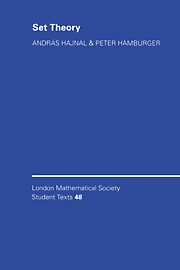Book contents
- Frontmatter
- Contents
- Preface
- Part I Introduction to set theory
- Appendix. An axiomatic development of set theory
- Part II Topics in combinatorial set theory
- 12 Stationary sets
- 13 Δ-systems
- 14 Ramsey's Theorem and its generalizations. Partition calculus
- 15 Inaccessible cardinals. Mahlo cardinals
- 16 Measurable cardinals
- 17 Real-valued measurable cardinals, saturated ideals
- 18 Weakly compact and Ramsey cardinals
- 19 Set mappings
- 20 The square-bracket symbol. Strengthenings of the Ramsey counterexamples
- 21 Properties of the power operation. Results on the singular cardinal problem
- 22 Powers of singular cardinals. Shelah's Theorem
- Hints for solving problems of Part II
- Bibliography
- List of symbols
- Name index
- Subject index
14 - Ramsey's Theorem and its generalizations. Partition calculus
Published online by Cambridge University Press: 10 May 2010
- Frontmatter
- Contents
- Preface
- Part I Introduction to set theory
- Appendix. An axiomatic development of set theory
- Part II Topics in combinatorial set theory
- 12 Stationary sets
- 13 Δ-systems
- 14 Ramsey's Theorem and its generalizations. Partition calculus
- 15 Inaccessible cardinals. Mahlo cardinals
- 16 Measurable cardinals
- 17 Real-valued measurable cardinals, saturated ideals
- 18 Weakly compact and Ramsey cardinals
- 19 Set mappings
- 20 The square-bracket symbol. Strengthenings of the Ramsey counterexamples
- 21 Properties of the power operation. Results on the singular cardinal problem
- 22 Powers of singular cardinals. Shelah's Theorem
- Hints for solving problems of Part II
- Bibliography
- List of symbols
- Name index
- Subject index
Summary
In 1930, the British mathematical logician F. P. Ramsey proved the result, today known as Ramsey's Theorem, that we will discuss at the beginning of this section. Ramsey's set-theoretical theorem has surprising and deep applications in several branches of mathematics. We will discuss only one application to model theory, but we would like to mention that this theorem also has applications in geometry and analysis.
The possibility of studying various generalizations of the theorem is even more important. The so-called Ramsey theory is now an important subject of finite combinatorics, while the study of its transfinite generalizations brought about an important branch of set theory, now called partition calculus, in the the wake of investigations by Paul Erdős and Richard Rado. The calculus of partitions has important applications outside set theory mainly in settheoretic topology and universal algebra. In this section, we will give a glimpse of some results of partition calculus, without in any way aiming at completeness. For this reason, right at the outset, we formulate the problem studied in Ramsey's Theorem in somewhat general terms.
Definition 14.1.Let X be an arbitrary set, λ, a cardinal, and γ, an ordinal Given a mapping f of the set [X]λ into γ, we call f a λ-partition of (or with) γ colors of the set X. If Y ⊂ X, ν < γ, and f “[Y]λ = {ν}, then we say that Y is homogeneous of (or in) color ν with respect to f.
Information
- Type
- Chapter
- Information
- Set Theory , pp. 164 - 183Publisher: Cambridge University PressPrint publication year: 1999
